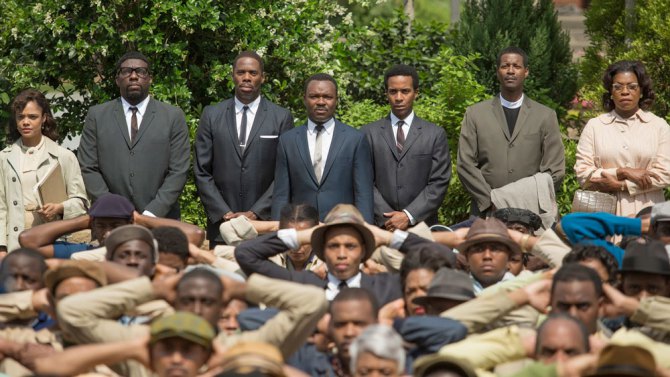Selma manages to take the microcosm of the marches in 1965 in Selma, Alabama to tell a sweeping saga that remains painfully relevant today. By focusing on this singular moment in a long battle, a vast epic is revealed.
Much that is in the news today shouts unfinished to the battle fought by Dr. Martin Luther King, Jr. and his courageous supporters in Selma. For example, several members of the cast appeared on the red carpet for the opening of Selma wearing tee shirts emblazoned “I can’t breathe.”

David Oyelowo stars as Dr. Martin Luther King, Jr. He managed to portray King as very human with doubts and fears and failings while painting a portrait of King as a brilliant organizer, an astute politician, a moving orator, and an inspired showman. It is a stunning performance giving us a very real man who managed to achieve greatness. It’s a portrait both intimate and historic.
The story alternates between quiet moments and horrific moments of violence. The two opening scenes are good examples of this contrast. There’s Annie Lee Cooper (Oprah Winfrey) attempting to register to vote in an act of quiet determination. Then there’s the church explosion that killed 4 young black girls as they scampered down the church stairs discussing their hairdos. Mixed with these types of gut wrenching scenes are strategy sessions and arguments between civil rights movement leaders and meetings between Dr. King and government leaders.
I was impressed by the careful way King picked Selma as the perfect place to stage a massive demonstration for voting rights after President Lyndon Johnson (Tom Wilkinson) refused to take action on the issue with the speed King needed.
There were actually 3 marches in the attempt to go from Selma to Montgomery. The first became known as “Bloody Sunday.” About 600 people arrived for a demonstration march on Sunday March 7, 1965. State troopers met the demonstrators at the edge of Selma on the Edmund Pettus Bridge and chased, clubbed, tear gassed, and terrorized the demonstrators into a retreat.
The Edmund Pettus Bridge, by the way, was named for a head of the KKK. It bears the same name today.
The Bloody Sunday demonstration was televised. Thousands of people flocked to Selma in support. The second march was much bigger because of the publicity. When this group walked across the bridge, the state troopers moved aside. King stood looking at the situation for a long moment. He knelt to pray. As one, the marchers behind him did the same. Finally he stood up and turned back. He was waiting for a legal ruling that would protect the marchers and he got it the next day.
The third attempt was the one that made it over the bridge and all the way to Montgomery, where Dr. King gave a speech on the steps of the capitol. Finally, President Johnson was forced to act to remove restrictions on voting such as poll taxes, literacy tests, and other impediments meant to keep black citizens from voting.
The horror was visceral: the bodies of dead children amid the concrete rubble of a bombed church, the thuds of clubs and the screams of pain and terror as white men on horses attacked fleeing black men and women on the bridge.
The hate filled words of men like Gov. George Wallace (Tim Roth) and Sheriff Jim Clark (Stan Houston) were as terrifying as the scenes of chaos and attack. They are the same words we hear today. They are a reminder that for each victory like this one in 1965, there are still white men fighting to deny certain Americans their civil rights.
The music chosen as background in certain scenes was completely apt. The lyrics told the story as the story was being told.
The cast of the film was very large. There are many real people in this story whose names we know: Coretta Scott King, Andrew Young, Ralph Abernathy, J. Edgar Hoover, John Lewis, Malcolm X. Many other characters whose names are not so famous were also in the story. All were played by actors whose faces I’m sure you recognize. I’m not going to list all the actors in these parts, but I do want to acknowledge those excellent performances.
The film was written by Paul Webb and directed by Ava DuVernay. Cinematography was by Bradford Young. All 3 deserve Oscar nominations, as does the film for Best Picture.

Pingback: The Old Ain't Dead Top 10 of 2015 - Old Ain't Dead
Pingback: Review: Trumbo - Old Ain't Dead